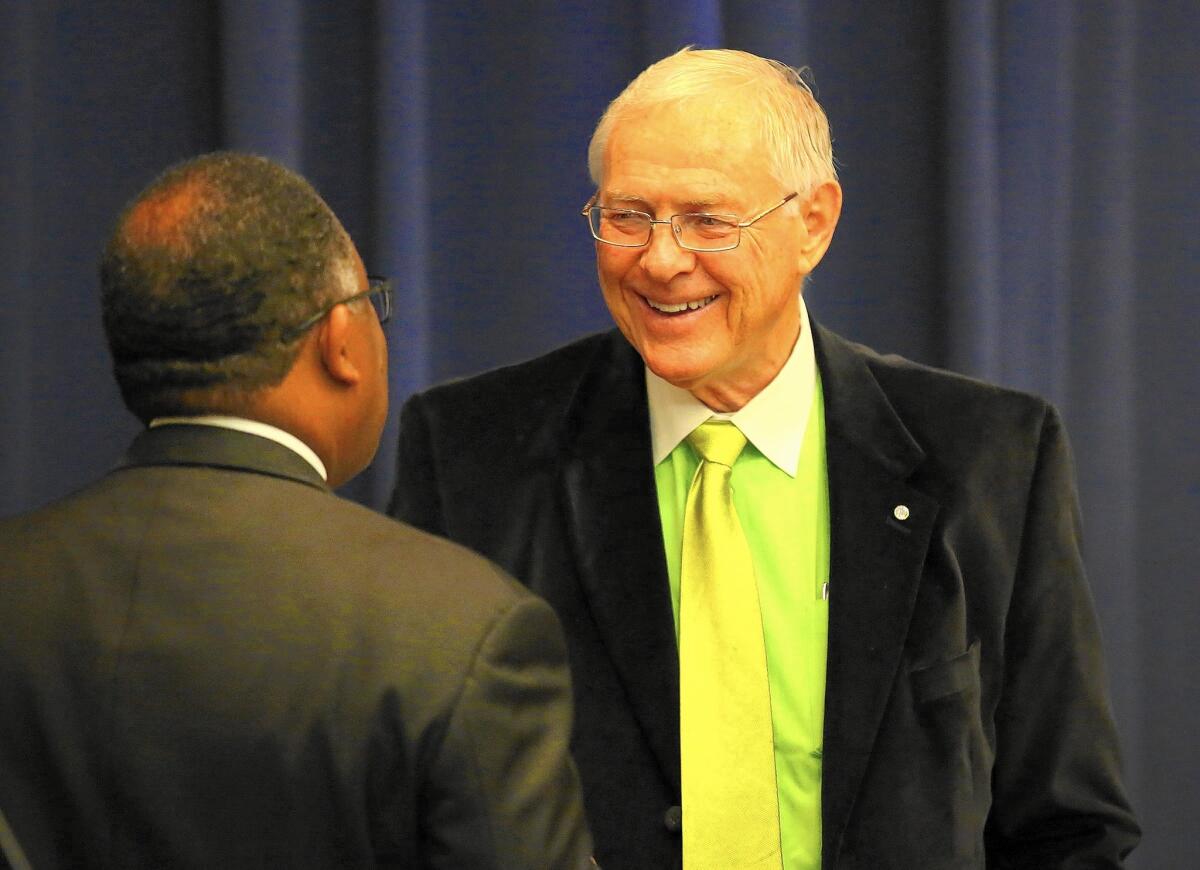This year’s election could usher in liberal ‘supermajority’ on L.A. County supervisors board

- Share via
While the contentious presidential contest has drawn most of the spotlight in the lead-up to California’s June primary, the election also marks the next phase of a sea change in Los Angeles County government.
Two conservative, longtime members of the Board of Supervisors are preparing to step down, paving the way for a continued leftward shift on the powerful panel. The election could usher in a liberal “supermajority” on the board for the first time in modern history.
The seats are low-profile but coveted. The county manages a $28-billion budget and runs the nation’s largest jail and foster care systems and second-largest public health system. Political observers sometimes refer to the supervisors as the “five little kings.”
The two Republicans on the officially nonpartisan five-member board, Don Knabe and Michael D. Antonovich, will be forced out in December by term limits passed in 2002, which limited supervisors to three four-year terms. Knabe and Antonovich have been on the board since 1996 and 1980, respectively.

Supervisor Michael D. Antonovich, right, with Supervisor Mark Ridley-Thomas, has served on the board since 1980.
A high-profile and well-funded Democrat, Rep. Janice Hahn (D-San Pedro), appears to be the favorite to take Knabe’s seat, representing the South Bay and southeast county areas. Hahn, a former Los Angeles city councilwoman and daughter of former longtime county Supervisor Kenneth Hahn, is giving up her congressional seat to run for the county position.
She faces a Republican challenger, Knabe aide and former Manhattan Beach Councilman Steve Napolitano; and a lesser-known Democrat, Whittier school board member Ralph Pacheco. But with campaign funds dwarfing her opponents’ and high name recognition, most observers say Hahn is the presumed front-runner.
“I don’t see that she’s going to be seriously challenged,” said Jaime Regalado, professor emeritus of political science at Cal State L.A. “Labor’s going to be backing her big time, as are others sitting on the board right now.”
Knabe, who has endorsed Napolitano, said he believes the race will be competitive, but acknowledged Hahn’s advantage: “The reality is, it’s hers to lose at this point.”
The race to fill the north county seat occupied by Antonovich for the last 36 years is more crowded, but the seat appears likely to remain in Republican hands. The eight contenders include Antonovich’s chief of staff, Kathryn Barger; prosecutor Elan Carr; L.A. Councilman Mitch Englander; state Sen. Bob Huff; and Glendale Mayor Ara Najarian — all Republicans who have sought to establish themselves as champions of public safety and business-friendly initiatives.
Three Democrats in the contest, Darrell Park, Billy Malone and Raj Pal Kahlon, have amassed relatively small amounts of money.
Park has the endorsement of the county Democratic Party, but labor unions have largely lined up with the Republican candidates. Public sector unions, including SEIU Local 721 — the union representing the bulk of county employees — and the county sheriff’s deputies and firefighters’ unions, have endorsed Barger, and private sector unions representing construction industry workers have been backing Englander.
The 2014 elections marked the beginning of the board’s tilt to the left, with a pair of labor-backed, progressive Democrats — Sheila Kuehl and Hilda Solis — replacing a pair of more centrist Democrats, Zev Yaroslavsky and Gloria Molina.
Over the last year, the new supervisors, who joined Mark Ridley-Thomas in a new progressive majority, have passed a plan to increase the county’s minimum wage to $15 an hour, downsized plans to build a new Men’s Central Jail, and launched a series of plans to set aside more money for affordable housing and services for the homeless.
“This is a new game already with the 3-2 liberal majority on the board as it is, but a 4-1 split — it’s unheard of,” Regalado said. “Four out of five is going to be a lock on any major issue.”
These two elections mark the end of the ‘five kings’ era of the Board of Supervisors.
— Dan Schnur, director of the Jesse M. Unruh Institute of Politics at USC
Some, including Knabe, voiced concerns that the configuration could result in reckless spending. In 2014, with Molina and Yaroslavsky on their way out the door, the previous board adopted new fiscal policies requiring a four-fifths supermajority to approve any pay increases for county workers.
“You could spend all the money you want to spend, whether you have it or not, with a four-fifths majority,” Knabe said.
Hahn’s campaign spokesman, Dave Jacobson, said she wants to be part of continuing reforms on “social and economic justice issues” and in the county criminal justice system. But he also pointed to her championship of the Port of Los Angeles and endorsements from business groups and conservative political figures, including former Mayor Richard Riordan.
“Janice has been a champion of working people throughout her career, but she’s also got expansive support from business,” he said.
Raphael Sonenshein, executive director of the Pat Brown Institute for Public Affairs at Cal State L.A., said a liberal supermajority on the board could potentially introduce an element of instability.
“When you get more than you need to have a majority, it introduces more flexibility, but it also increases the possibility that they’ll find things to disagree about,” he said.
The districts represented by Knabe and Antonovich have seen demographic shifts since the supervisors were first elected. In both districts, the white population has shrunk and the Latino population has grown markedly over the last 20 years. The Asian population has also grown substantially, particularly in Antononich’s district, and the black population has seen more modest growth.
When Antonovich was first elected, Democrats held a narrow, 49% to 42% edge in party registration over Republicans in the 5th District. Since then, the number of voters declining to state their party preference has grown significantly, now representing nearly one-third of those registered. But among those who stated a party preference, Democrats significantly outnumber Republicans, 40% to 24%.
In Knabe’s district, where Democrats made up 51% of the electorate to 39% for Republicans when he was first elected, the number of independent voters has also grown, representing one-quarter of registered voters, while the spread between Democrats and Republicans has widened — 45% to 26%.
Dan Schnur, director of the Jesse M. Unruh Institute of Politics at USC, said that no matter what happens in this year’s election, the political landscape of the county will change dramatically with the departure of the last two supervisors from the preterm-limits days.
“These two elections mark the end of the ‘five kings’ era of the Board of Supervisors,” he said.
Twitter: @sewella
ALSO
Latinos and women are blunting Trump and Sanders in California’s primaries
Poor residents were promised Wi-Fi service. The Times found they didn’t get it
More to Read
Sign up for Essential California
The most important California stories and recommendations in your inbox every morning.
You may occasionally receive promotional content from the Los Angeles Times.











